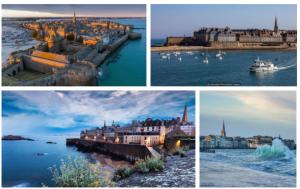With the town of Saint-Malo, it is said that the sea has permeated the cultural life of the people here, making everything have a “salty taste” . Even wine is “salty” , because it is soaked in the sea instead of stored in the cellar.
If you are in the town of Saint-Malo, province of Ille-et-Vilaine, in the Brittany region of France, even if you have not seen the sea, you will still feel the embrace of the ocean.
People like St-Malo for its old fortresses, and Brittany for its long history. Since the 1st century BC, this place has been a crowded and bustling port city. Even now, it still invites visitors to visit.

The beautiful town of Saint-Malo.
Because of its location with the highest tide level in Europe, St-Malo is constantly hit by strong waves against the foot of the ancient granite wall. However, instead of being apprehensive, local residents – the Malouin people – joked that it was a passionate kiss between sea and land.
Every summer, tourists from England cross the English Channel to St-Malo, while the French go down the Rance River to the mouth of the river to visit the town of ancient fortresses. It is here that they feel the most profound influence of the sea.
The sea permeates Malouin culture and identity, making everything salty.
“When I’m in St-Malo, even when I can’t see the sea, I can still feel ‘she.’ I always know ‘she’ is right here” – Yannick Heude, who created a new tradition, brews wine under the sea confided.
Because of the very obvious presence of the sea, it seems that every food and drink at St-Malo has the smell of the ocean. It is as if the sea has penetrated into the land, into the water, into the cooking enthusiasm of the chefs. And then during a rowing at sea, Heude suddenly wanted to realize the idea of brewing wine in salt water.
The day that Heude decided to use the sea to flavor that wine was only 15 years ago. According to him, a friend on the same boat that day, wanting to have some special wine to celebrate the birth of his upcoming son said, “Hey, what if I soak some wine in the water? huh”.
And Heude replied: “If you like it, let me do it”.
Unexpectedly, that small experiment became the new tradition of St-Malo. Not only that, it has also developed into a national phenomenon.
Today, visitors to St-Malo, if the occasion is right (because it takes 12 months to brew wine under the sea, but only after 6 months, it’s sold out) can enjoy wine soaked on the seabed . After a small experiment 15 years ago, Heude regularly brings the wine to the seabed every year.
Of course, in addition to momentary interest, he also relied on scientific knowledge. Off the coast of Brittany, where Heude soaks his wine 15 meters deep, the ocean temperature is always 9-10 degrees Celsius, equivalent to the temperature in an underground wine cellar. Sea water will also help block UV rays from entering.

Sea water helps prevent UV rays from reaching the wine bottle.
In addition, he also took advantage of the strong tide phenomenon. Because it steadily rises and falls every day, the reverse current will cause the bottles to slowly tilt to the right, stand up, and then slowly tilt to the left.
This process is similar to the technique of making champagne. Wine residue will settle on both sides and bottom of the bottle, making the taste more intense each day.

Wine under the sea needs 12 months, but after only 6 months, it sold out.
Each year, Heude also changes the wines that are soaked in seawater. Because the taste of each wine becomes different after being picked, he is very interested.
“In the taste of wine aged on the bottom of the sea, it seems to have everything,” said Heude. “There’s wine, there’s shrimp, there’s scallops, there’s fish, there’s spring vegetables, there’s freshly dug potatoes. It’s all mixed in. It’s really all there.”

